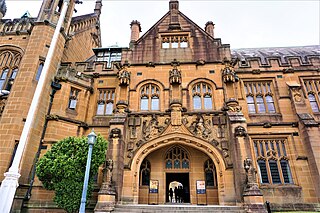
The Nicholson Museum was an archaeological museum at the University of Sydney home to the Nicholson Collection, the largest collection of antiquities in both Australia and the Southern Hemisphere. Founded in 1860, the collection spans the ancient world with primary collection areas including ancient Egypt, Greece, Italy, Cyprus, and the Near East. The museum closed permanently in February 2020, and the Nicholson Collection is now housed in the Chau Chak Wing Museum at the University of Sydney, open from November 2020. The museum was located in the main quadrangle of the University.

The sculpture of ancient Greece is the main surviving type of fine ancient Greek art as, with the exception of painted ancient Greek pottery, almost no ancient Greek painting survives. Modern scholarship identifies three major stages in monumental sculpture in bronze and stone: the Archaic, Classical (480–323) and Hellenistic. At all periods there were great numbers of Greek terracotta figurines and small sculptures in metal and other materials.
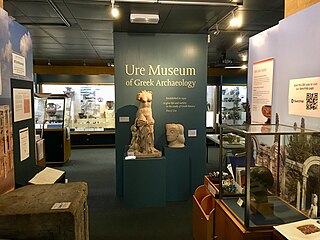
The Ure Museum of Greek Archaeology is a museum of ancient Mediterranean archaeology, primarily that of ancient Greek civilisation but with smaller collections of Egyptian, Etruscan and Roman items. It contains one of the most important collections of ancient Greek pottery in the United Kingdom. The museum is part of the University of Reading's University Museums and Special Collections Services (UMASCS), and is located in and works closely with the university's Department of Classics. The museum is situated on the university's Whiteknights Campus, about 2 miles (3.2 km) from the centre of the English town of Reading, Berkshire. The museum is open to the public and entry is free.
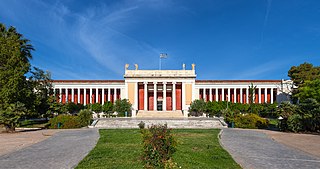
The National Archaeological Museum in Athens houses some of the most important artifacts from a variety of archaeological locations around Greece from prehistory to late antiquity. It is considered one of the greatest museums in the world and contains the richest collection of Greek Antiquity artifacts worldwide. It is situated in the Exarcheia area in central Athens between Epirus Street, Bouboulinas Street and Tositsas Street while its entrance is on the Patission Street adjacent to the historical building of the Athens Polytechnic university.

The naiskos is a small temple in classical order with columns or pillars and pediment.
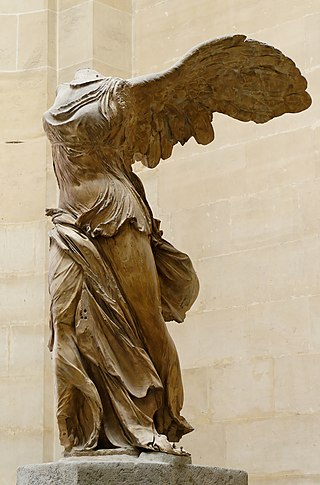
Hellenistic art is the art of the Hellenistic period generally taken to begin with the death of Alexander the Great in 323 BCE and end with the conquest of the Greek world by the Romans, a process well underway by 146 BCE, when the Greek mainland was taken, and essentially ending in 30 BCE with the conquest of Ptolemaic Egypt following the Battle of Actium. A number of the best-known works of Greek sculpture belong to this period, including Laocoön and His Sons, Venus de Milo, and the Winged Victory of Samothrace. It follows the period of Classical Greek art, while the succeeding Greco-Roman art was very largely a continuation of Hellenistic trends.

Etruscan art was produced by the Etruscan civilization in central Italy between the 10th and 1st centuries BC. From around 750 BC it was heavily influenced by Greek art, which was imported by the Etruscans, but always retained distinct characteristics. Particularly strong in this tradition were figurative sculpture in terracotta, wall-painting and metalworking especially in bronze. Jewellery and engraved gems of high quality were produced.

Delphi Archaeological museum is one of the principal museums of Greece and one of the most visited. It is operated by the Greek Ministry of Culture. Founded in 1903, it has been rearranged several times and houses the discoveries made at the Panhellenic sanctuary of Delphi, which date from the Late Helladic (Mycenean) period to the early Byzantine era.

The Archaeological Museum of Nafplio is a museum in the town of Nafplio of the Argolis region in Greece. It has exhibits of the Neolithic, Chalcolithic, Helladic, Mycenaean, Classical, Hellenistic and Roman periods from all over southern Argolis. The museum is situated in the central square of Nafplion. It is housed in two floors of the old Venetian barracks.

The Archaeological Museum of Piraeus contains mainly sculptures, discovered in Piraeus and in the area of the Attic coast from Bronze Age to Roman times,
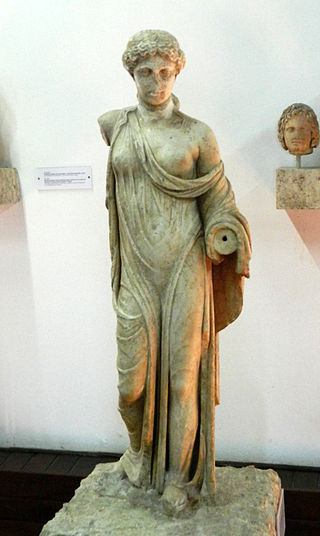
The Archaeological Museum of Lamia is a museum within the archaeological site of Lamia Castle in Lamia, Greece. The museum is housed in a refurbished barracks built in 1830 by King Otto of Greece. It presents prehistoric and Classical antiquities, covering the Neolithic era, Helladic period, Early Iron Age, Archaic, Classical and Hellenistic periods.

The Archaeology Museum of the American University of Beirut in Beirut, Lebanon is the third oldest museum in the Near East after Cairo and Constantinople.

The Archaeological Museum of Pella is a museum in Pella in the Pella regional unit of Central Macedonia. The building was designed by architect Kostas Skroumpellos and is on the site of the ancient city of Pella. It was completed in 2009 with the support of the Greece's Third Community Support Framework.

Ancient Greek art stands out among that of other ancient cultures for its development of naturalistic but idealized depictions of the human body, in which largely nude male figures were generally the focus of innovation. The rate of stylistic development between about 750 and 300 BC was remarkable by ancient standards, and in surviving works is best seen in sculpture. There were important innovations in painting, which have to be essentially reconstructed due to the lack of original survivals of quality, other than the distinct field of painted pottery.

Konya Archaeological Museum is a state archaeological museum in Konya, Turkey. Established in 1901, it had been relocated twice before moving to its present location in 1962. One of the most prominent displays in the museum is of sarcophagi and other antiquities from the ancient city of Çatalhöyük. Other exhibits relate to the Neolithic, Bronze Age, Iron Age, Classical, Hellenistic, Roman and the Byzantine periods; artifacts consist of ceramic ware, stone and bronze wares, ornaments and inscriptions. Among the objects displayed is a marble sarcophagus of the 3rd century AD, with elaborate relief sculptures depicting the life of Hercules. In the outer open yard of the museum there are a number of small sculptures, sarcophagi, column capitals, and samples of epigraphy.
Jennifer M. Webb is an archaeologist who was born in 1953, in Melbourne, Australia. She currently holds a position as a Charles La Trobe Research Fellow at La Trobe University, a position she took in 2008. Recent research includes a volume covering documentation of tombs at Lapithos that had been excavated in the early 1900s, for which she was awarded a grant from the White Levy program.
The University of Queensland R.D. Milns Antiquities Museum is a collection housed on the St Lucia campus of the university. It was built to further the study of the classical civilisations of Greece, Rome, Egypt, and the Near East by secondary students, tertiary students and researchers as well as the general public.
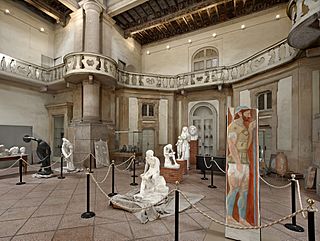
The Museum of Archeology of the University of Pavia was established in 1819 and is, together with that of Padua, one of the oldest in Italy. The museum is located inside the ancient San Matteo hospital in Pavia.




















